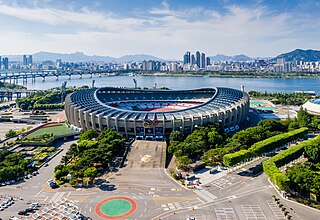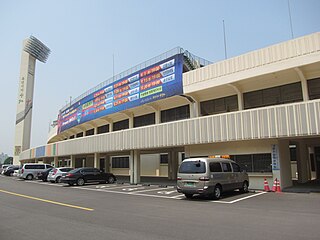
The 1988 Summer Olympics, officially known as the Games of the XXIV Olympiad and commonly known as Seoul 1988, was an international multi-sport event held from 17 September to 2 October 1988 in Seoul, South Korea. 159 nations were represented at the games by a total of 8,391 athletes. 237 events were held and 27,221 volunteers helped to prepare the Olympics.

Yongin is a city in the Seoul Capital Area, the largest in Gyeonggi Province, South Korea. With a population over 1 million, the city has developed rapidly since the 21st century, recording the highest population growth of any city in the country. Yongin is home to Everland and Caribbean Bay, South Korea's most popular amusement and water parks. The city is also home to the Korean Folk Village, the largest of its kind. Yongin-si is a multi-nuclear city with multiple urban centers, not a single nuclear structure, and Giheung-gu crosses the Yeongdong Expressway and Dongbaek, while Suji-gu crosses Pungdeokcheon Stream and Jukjeon.

The Seoul World Cup Stadium (Korean: 서울월드컵경기장), also known as Sangam Stadium, is a stadium used mostly for association football matches. The venue is located in 240, World Cup-ro, Mapo-gu, Seoul, South Korea. It was built for the 2002 FIFA World Cup and opened on November 10, 2001. It is currently the second largest stadium in South Korea after Seoul Olympic Stadium, and is the 2nd largest rectangular stadium in Asia. It was designed to represent the image of a traditional Korean kite. The stadium has a capacity of 66,704 seats, including 816 seats for VIP, 754 seats for press and 75 private Sky Box rooms, each with a capacity for 12 to 29 persons. Due to table seats installation, capacity was reduced from 66,806 seats to 66,704 seats in February 2014. Since the World Cup it has been managed by the Seoul Metropolitan Facilities Management Corporation (SMFMC). FC Seoul moved to the Seoul World Cup Stadium in 2004.

Dongdaemun Stadium (Korean: 동대문운동장) was a sports complex in Seoul, South Korea and included a multi-purpose stadium, a baseball park and other sports facilities. It was located near Dongdaemun or Great East Gate. The surrounding Dongdaemun market had many vendors selling athletics-related goods. It was demolished in 2008 to make way for the Dongdaemun Design Plaza & Park.

The Seoul Olympic Stadium, a.k.a “Jamsil Olympic Stadium", is a multi-purpose stadium in Seoul, South Korea. It is the main stadium built for the 1988 Summer Olympics and the 10th Asian Games in 1986. It is the centrepiece of the Seoul Sports Complex in the Songpa District, in the southeast of the city south of the Han River. It is the largest stadium in South Korea.

Suwon Sports Complex is a group of sports facilities in Suwon, South Korea. The complex consists of the Suwon Stadium, Suwon Baseball Stadium, and Suwon Gymnasium.

Manseok Park is a large public park in the Jeongja-dong area of Jangan-gu, Suwon, Gyeonggi Province, South Korea.

The Sydney Olympic Park Tennis Centre is a tennis and multi-purpose sports facility in the Sydney Olympic Park suburb of Sydney, New South Wales, Australia. The centre was built in 1999 and hosted the tennis events for the 2000 Summer Olympics. The venue hosted the Sydney International tournament from 2000 to 2019, the Sydney Tennis Classic in 2022, the ATP Cup in 2020 and 2022, and the United Cup since 2023. The main stadium in the centre is the Ken Rosewall Arena, which has a seating capacity of 10,500, and is capable of hosting multiple sports, including tennis and netball.

Seongnam Sports Complex is a group of sports facilities in Seongnam, South Korea.

The Stone Mountain Tennis Center was a tennis venue at Stone Mountain Park in Stone Mountain, Georgia, USA.

Daejeon Hanbat Sports Complex is a sports complex, comprising a multi-purpose stadium, a ballpark, Basketball courts, tennis courts and various other sports facilities in Daejeon, South Korea.
Jamsil Students' Gymnasium (Korean: 잠실학생체육관) is an indoor sporting arena located in Seoul, South Korea. The capacity of the arena is 7,500 and was built from November 1972 to December 1976 to host Boxing events at the 1986 Asian Games and 2-years later the same sport on the 1988 Summer Olympics, and wheelchair basketball events at the 1988 Summer Paralympics.
Hanyang University Gymnasium is an indoor sporting arena located in Seoul, South Korea. The capacity of the arena is 8,000 people and was built in 1986 to host the volleyball events at 1986 Asian Games and during the 1988 Summer Olympics. It hosted a sport stacking task on The Amazing Race 29 and The Amazing Race Australia 4. An indoor gymnasium with two stories underground and four stories above ground with reinforced concrete truss structure built on the campus of Hanyang University in Haengdang-dong, Seongdong-gu. It is a building of 31,247 m2 with a building area of 31,247 m2 and its size is 80m * 80m * 26m. The floor of the stadium is 50m * 36m and the practice field: 37m * 21m. In the 1988 Seoul Olympics, it is offered as a volleyball arena. Evening games are possible.
Seoul National University Gymnasium is an indoor sporting arena located in Seoul, South Korea. The capacity of the arena is 5,000 and was built in 1986 to host table tennis and badminton (demonstration) events at the 1988 Summer Olympics.

Jamsil Indoor Swimming Pool is an aquatics venue located in Seoul, South Korea. It hosted the swimming, diving, water polo, synchronized swimming, and the swimming part of the modern pentathlon events at the 1988 Summer Olympics and the swimming at the 1988 Summer Paralympics. The venue was constructed from November 1977 to December 1980 and has a seating capacity of 8,000.

LetsRun Park Seoul, also known a Seoul Race Park or Seoul Racecourse Park is a 40,000 capacity Korean thoroughbred racetrack in Gwacheon, Gyeonggi-do, South Korea. It is host to many of Korea's most valuable thoroughbred horse races including the Korean Derby and Grand Prix. LetsRun Park Seoul is located next to Seoul Racecourse Park Station on Line 4 of the Seoul Metropolitan Subway. It is operated by the Korea Racing Authority (KRA).

The Seoul Olympic Cyclodrome is a velodrome located at the Olympic Park in Seoul, South Korea. It hosted the track cycling events of the 1988 Summer Olympics. It was constructed from September 1984 to April 1986 and has a seating capacity of 6,000.
Olympic Weightlifting Gymnasium (Korean: 올림픽역도경기장) located in the Olympic Park area of Seoul, South Korea. It was constructed between August 1984 and April 1986, and hosted the weightlifting at the 1986 Asian Games and two years later the same sport at 1988 Summer Olympics.

Seoul Sports Complex, a.k.a “Jamsil Sports Complex”, is a group of sports facilities in Songpa-gu in Seoul, South Korea. It was built for the 1986 Asian Games and 1988 Summer Olympics from December 1976 to September 1984. The complex is South Korea's largest integrated sports center, spanning an area of 402,816 m2. The complex consists of the Olympic Stadium, Auxiliary Stadium, Jamsil Arena, Jamsil Baseball Stadium, Jamsil Indoor Swimming Pool, Jamsil Inline Skating Rink and the Sports Park.

Taereung International Skating Rink is a speed skating oval in South Korea, used for training and competitions, operated by the Korean Olympic Committee. It is one of only two indoor long-track (400m) skating facilities in the country, and the most actively used, with Gangneung Oval completed in 2017 for the 2018 Winter Olympics but planned for conversion to a multi-sports and convention center. It is also one of the remaining active training grounds of the Korea National Training Center in Gongneung-dong, Nowon-gu in northeast Seoul; most other teams, including the short track and ice hockey teams, have moved to Jincheon National Training Center


















